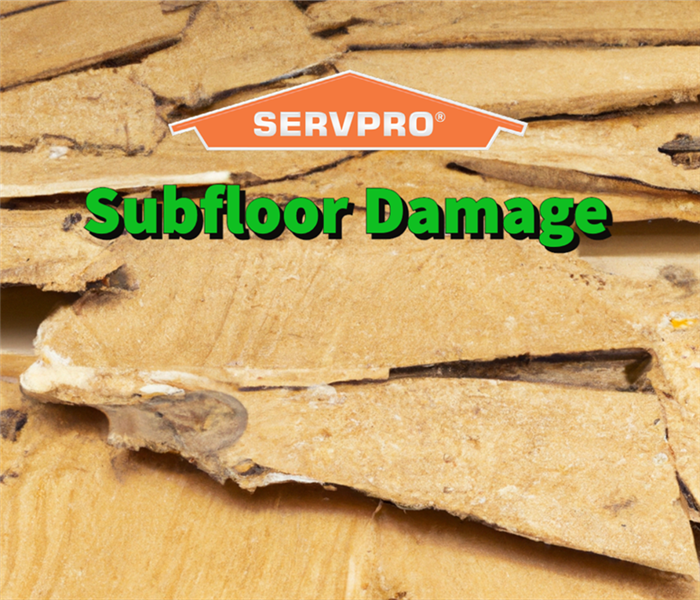Subfloor Damage Diagnosed: The #1 Guide to Home Health
6/26/2023 (Permalink)
The professionals at SERVPRO have seen subfloor damage lead to severe structural damage.
When it comes to your property, hidden dangers can lurk beneath the surface, often undetectable until they cause significant damage. One such threat is subfloor damage, a problem that can compromise your home or business's structural integrity.
This comprehensive blog post will explore the telltale signs of subfloor damage that every property owner should know.
But not to worry—SERVPRO is here to provide exceptional restoration services when disaster strikes! With our expertise, advanced techniques, and commitment to customer satisfaction, we are the restoration experts you can trust. So let's dive into subfloor damage and discover why SERVPRO is your go-to solution.
What is subfloor damage?
Subfloor damage refers to any structural deterioration affecting the subfloor, which is the layer beneath your floor's visible surface. The subfloor supports your flooring material and evenly distributes weight across the structure. Over time, subfloor damage can occur due to water leaks, termite infestations, or inadequate ventilation. Therefore, identifying subfloor damage early on is essential to prevent further deterioration and costly repairs.
What are the visible signs of subfloor damage?
In many cases, subfloor damage remains hidden, making it only possible to identify with a professional inspection. However, specific visible indicators may suggest underlying issues. One of the most noticeable signs is sagging or uneven floors. If you observe that your floorboards are no longer level or feel unstable underfoot, it could indicate subfloor damage. Additionally, cracks or gaps in your flooring material may signify subfloor damage.
Can subfloor damage cause soft or spongy floors?
Yes, subfloor damage often leads to soft or spongy floors, which can be concerning and dangerous. When moisture infiltrates the subfloor, it weakens the structural integrity of the materials, causing them to lose their rigidity. As a result, the floor may feel uneven, sink under pressure, or bounce when walked upon. Soft or spongy floors can pose safety hazards, making it imperative to address subfloor damage promptly.
Preventing subfloor damage: proactive measures for long-term protection
Preventing subfloor damage is critical to maintaining your property's structural integrity and longevity. By taking proactive measures, you can minimize the risk of subfloor deterioration and the associated costs of repairs.
Here are some essential tips you can take to prevent subfloor damage:
- Ensure proper ventilation: Proper ventilation prevents moisture buildup, a common cause of subfloor damage. Ensure your property has adequate ventilation, particularly in areas prone to high humidity, such as bathrooms, kitchens, and basements. Proper ventilation helps reduce the risk of moisture accumulation and mold growth.
- Address water leaks promptly: Water leaks are a leading cause of subfloor damage. Whether it's a leaking pipe, roof, or appliance, it's crucial to address any water leaks promptly. Regularly inspect your property for signs of leaks, such as water stains, dampness, or musty odors. If you notice any symptoms, immediately repair the leak and dry out the affected area to prevent further damage.
- Maintain proper plumbing: Regularly inspect your system to identify potential issues that could lead to water damage. Check for leaking pipes, loose connections, or signs of corrosion. Fixing plumbing issues early on can prevent water from seeping into the subfloor and causing damage.
- Install proper flooring: Choosing suitable materials and installation methods can contribute to subfloor protection. Opt for moisture-resistant flooring materials like tile, vinyl, or waterproof laminate. Additionally, ensure that flooring installations are done correctly, following manufacturer guidelines and utilizing moisture barriers as necessary.
- Monitor humidity levels: Excessive humidity can lead to moisture problems and contribute to subfloor damage. Use a dehumidifier in areas with high humidity, especially basements and crawl spaces. Monitoring humidity levels with a hygrometer can help you identify potential moisture issues and take corrective actions to prevent subfloor damage.
- Regular inspections and maintenance: Schedule regular inspections of your property, including the subfloor, to identify any signs of damage or potential risks. If necessary, choose a professional's services to assess the condition of your subfloor and provide recommendations for maintenance or repairs.
By implementing these preventive measures, you can significantly reduce the risk of subfloor damage and protect the structural integrity of your property. However, if subfloor damage does occur despite your best efforts, remember that SERVPRO is here to provide expert restoration services.
Wrapping up
Subfloor damage is a severe issue that can compromise your property's safety, integrity, and value. Identifying the signs early and taking swift action is crucial to minimize further damage and costly repairs.
That's where SERVPRO steps in as your trusted restoration partner. With our industry-leading expertise, state-of-the-art equipment, and unwavering commitment to excellence, we deliver comprehensive subfloor damage restoration services. From accurate assessment to efficient repairs and reliable customer support, SERVPRO ensures your property is restored to its pre-damage condition.

 24/7 Emergency Service
24/7 Emergency Service
